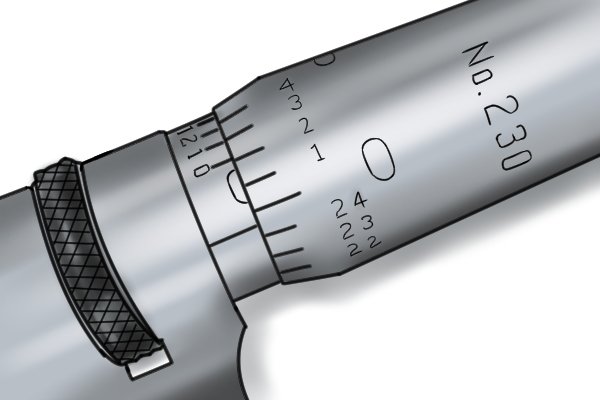
How to calibrate a micrometer?
Calibration
It is important to make sure that your micrometer is properly calibrated to ensure that the measurements you take are accurate and reliable. Calibration is often confused with zeroing. Zeroing ensures that the instrument is properly zeroed. The zero position is checked for accuracy, but the rest of the scale is considered correct. Essentially, the entire scale moves until zero is in the correct position. See How to Zero a Micrometer. Calibration ensures that the instrument is accurate at various points in its measurement range. The scale is checked for accuracy, not just zero position. Calibration should generally be done annually, but when you do it really depends on the frequency of use, the accuracy required, and the environment it's exposed to.
Calibration should generally be done annually, but when you do it really depends on the frequency of use, the accuracy required, and the environment it's exposed to.Calibration requires the micrometer to be in good working order. The spindle should rotate freely and cleanly through its entire range without any binding or backlash (backlash) in its movement.
If there are signs of wear, the spindle should be fully unscrewed and removed. The nut located on the threaded body should be slightly tightened. Reinsert the spindle and recheck its movement over the entire travel range. Adjust again if necessary. It would be a good idea to put a couple of drops of light oil on the threads when the micrometer is disassembled.
 Make sure the measuring surfaces (heel and spindle) are clean and free of grease and that the micrometer is fully covered.
Make sure the measuring surfaces (heel and spindle) are clean and free of grease and that the micrometer is fully covered.Hold up to a light and check for gaps between the mating surfaces of the anvil and spindle. Damage, usually caused by a fall, can be obvious if a light is visible between the two surfaces, or the anvil and spindle are out of alignment.
Sometimes mating surfaces can be repaired by sanding, but this is beyond the ability of most people due to the equipment involved. In general, any micrometer that cannot run smoothly, is damaged, or is defective should be discarded.If, upon inspection, the general condition is satisfactory, the next step in the calibration is to zero the micrometer. See How to zero a micrometer.
 Now that the micrometer is properly maintained and zeroed, it's time to move on to the scale.
Now that the micrometer is properly maintained and zeroed, it's time to move on to the scale.For accurate calibration, all measurements should be taken at room temperature, i.e. 20°C. All instruments and test equipment should also be at room temperature, so they should ideally be allowed to rest in the test room to acclimate if stored elsewhere.
It is good practice to use equipment that is at least four times more accurate than the instrument being calibrated.The scale of the micrometer cannot be changed, but it can be checked against known measured values, which should be referred to the National Standards Institute.
Slip gauges are used to accurately check the micrometer scale. These are blocks of hardened steel, which are precisely manufactured to specific dimensions.Each size will be engraved on a separate block. Slip sensors can be used alone or together with other slip sensors to test a specific measurement. Be careful when handling slip sensors - they are precise, calibrated pieces of equipment and should be handled with respect.
Take measurements at various arbitrary points on the scale, eg 5mm, 8.4mm, 12.15mm, 18.63mm by selecting different combinations of sliding gauges.Record the pressure gauge reading and the micrometer reading. It's a good idea to also write down the difference between the two. The more measurements you take, the better the picture of the condition of your micrometer will be.
If you are remeasuring a particular size, it is a good idea to include this in your calibration checks as well, as this will be the area where your micrometer scale will be most at risk for wear. "Calibration Certificate.jpg" image to go here. All text is in Greek except for the heading, "Certificate of Calibration". All data collected must then be documented in a "Certificate of Calibration", which will include details of the calibrated instrument, including model and serial number, date, time and place of calibration, the name of the person and details of the equipment used to perform the calibration, including the model number and serial number.Calibration does not correct any deviation of the micrometer reading from actual measurements, but instead provides a record of the condition of the micrometer.
If any of the tested dimensions is out of range, then the micrometer should be rejected. The allowable error will be determined by usage. For example, precision engineering manufacturers will have a more rigorous approach to micrometer accuracy than some other industries and DIY users, but it really depends on what you want to measure and the accuracy required. Comparing past calibration certificates allows the user to make predictions about timing. micrometer service.
